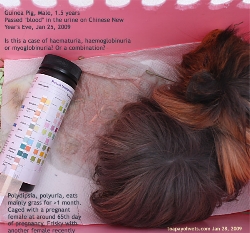Guinea Pig, Male, 5 years,
900 grams.
How do you remove the big
tumour without killing the guinea pig? This was Chinese New
Year's Eve and the mum had starved the pet overnight in
preparation for the surgery.
What mum wanted was a live guinea pig at the end of surgery.
Injectable Zoletil IM sedated the guinea pig. He was still
feeling active. I gave him isoflurane gas anaesthesia at 5% for <10 seconds.
It is
important that minimal gas is given. A gas mask fitting the
snout of the guinea pig brought into the gas. There was slight salivation
drooling from his mouth as he breathed in the gas.
I did not use
atropine to prevent salivation as this might affect the guinea
pig after surgery.
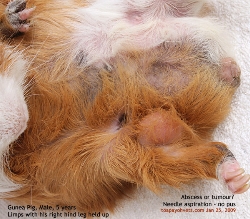 "Check
his eyelids," I taught my assistant who was holding the mask
how to elicit the eyelid blinking reflex. The guinea pig
blinked when I touched his eyelids, meaning that he was not
under surgical anaesthesia yet. "Check
his eyelids," I taught my assistant who was holding the mask
how to elicit the eyelid blinking reflex. The guinea pig
blinked when I touched his eyelids, meaning that he was not
under surgical anaesthesia yet.
It is difficult to give just sufficient anaesthetic gas
without killing the patient. I was using 5% isoflurane gas and
a bit overdose would kill him. I would check his blinking
reflex and took off the gas mask as soon as the reflexes were
gone.
His skin lump was really big. More than 1 cm in diameter. I
inserted a needle to aspirate but no pus came out. So, it
would be a tumour. There was a small bluish bruise as
the guinea pig's tumour rubbed against the floor of his cage.
"He walks with a limp and with his right leg held up high,"
the son said. So he had surfed the internet to find out more
about the problem and which veterinarian to consult.
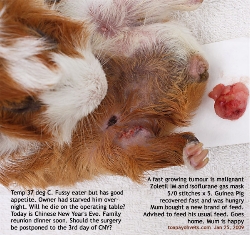 Mum
said, "Last week, there was no lump in this leg."
Therefore, this could be a malignant tumour if it has
increased to such a large size in one week. Mum
said, "Last week, there was no lump in this leg."
Therefore, this could be a malignant tumour if it has
increased to such a large size in one week.
"The guinea pig is old," I replied. "This large lump is likely
a tumour - a soft fatty tumour." The mother and son left the
Surgery while I admitted the guinea pig. It would be better
for them not to hang around as they would be stressed. Whether
the guinea pig would survive or not on the operating table
depends on so many factors. Death on the operating table was
not a good thing on Chinese New Year's Eve. Every relative at
the Family Reunion Dinner later would get to know about the
death and know which vet did it.
There was no delay for this surgery as the tumour might double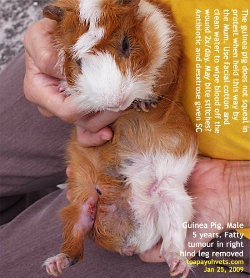 in size over one week. Under the lightest gas anaesthesia, I
cut the skin and shell out the fat tumour. 5 skin stitches of 5/0 absorbable sutures closed
the skin wound after removal of the big fatty tumour. An
antibiotic and dextrose saline SC given as the patient
staggered to stand up.
in size over one week. Under the lightest gas anaesthesia, I
cut the skin and shell out the fat tumour. 5 skin stitches of 5/0 absorbable sutures closed
the skin wound after removal of the big fatty tumour. An
antibiotic and dextrose saline SC given as the patient
staggered to stand up.
Within 5 minutes he was looking around for food. He had been
starved overnight. "Give him some pellets," I asked my assistant.
This was a finicky eater but he ate one pellet. I phoned the
mum and son to bring him home.
They were already on the way to the Surgery. The mum's face lit up as she
saw that the guinea pig greeted her and was walking normally,
with four legs on the ground.
She had
bought a new bag of guinea pig food from a pet shop. "It
is best that the guinea pig eats the same type of food before
the surgery," I advised. "Any changes in feed may cause stress
and diarrhoea."
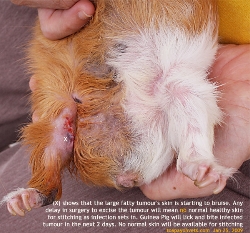 The family reunion dinner must be a happy one for the mum who
was the caregiver for this guinea pig. The guinea pig might or
might not bite off the stitches. Mum would need to use a piece
of facial cotton with clean water and wipe off the blood or
dirt twice a day. It is of course, not practical to get the
guinea pig to wear an Elizabeth collar to prevent biting.
Overall, I would expect him not to bite the stitches off as
the majority of his incised skin was not infected as his
tumour was only slightly bruised. The family reunion dinner must be a happy one for the mum who
was the caregiver for this guinea pig. The guinea pig might or
might not bite off the stitches. Mum would need to use a piece
of facial cotton with clean water and wipe off the blood or
dirt twice a day. It is of course, not practical to get the
guinea pig to wear an Elizabeth collar to prevent biting.
Overall, I would expect him not to bite the stitches off as
the majority of his incised skin was not infected as his
tumour was only slightly bruised.
A large tumour requires more
anaesthesia and increases the risk of the pet dying on the operating
table. A big incision means that the pet can lick off the stitches
and create a bigger problem of a big hole that is hard to stitch and
heal.
Therefore, monitor your old pet daily. If he is not walking
normally, find out why.
Get tumours removed when they are small. Be Kind to older
Guinea Pigs - Spot their tumours early when they are small and get
them removed by your vet promptly. Longer anaesthesia and old age increase the
risk of the guinea pig dying on the operating table. Deaths on the
operating table can be prevented if the owner takes the time to
groom and check his animal companion every day and get the small
tumour removed.
|
 TOA
PAYOH VETS
TOA
PAYOH VETS